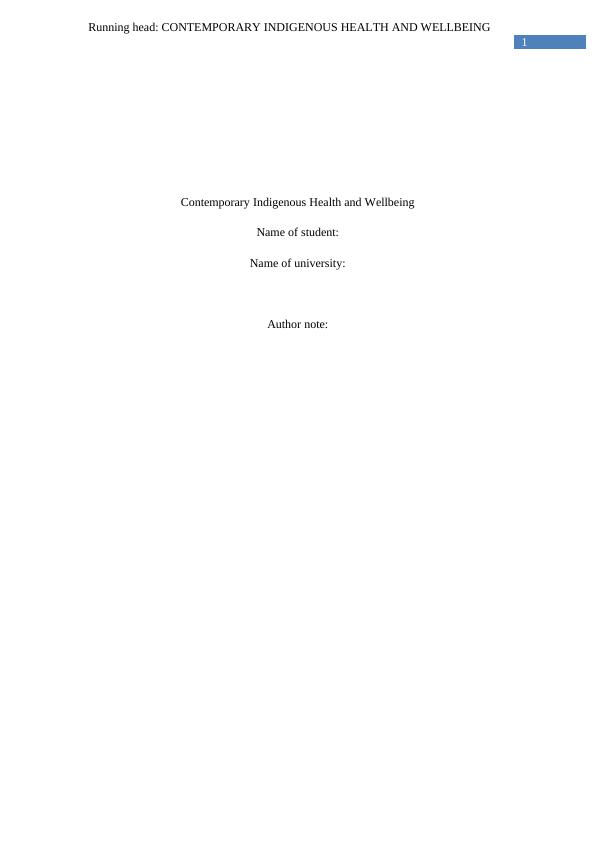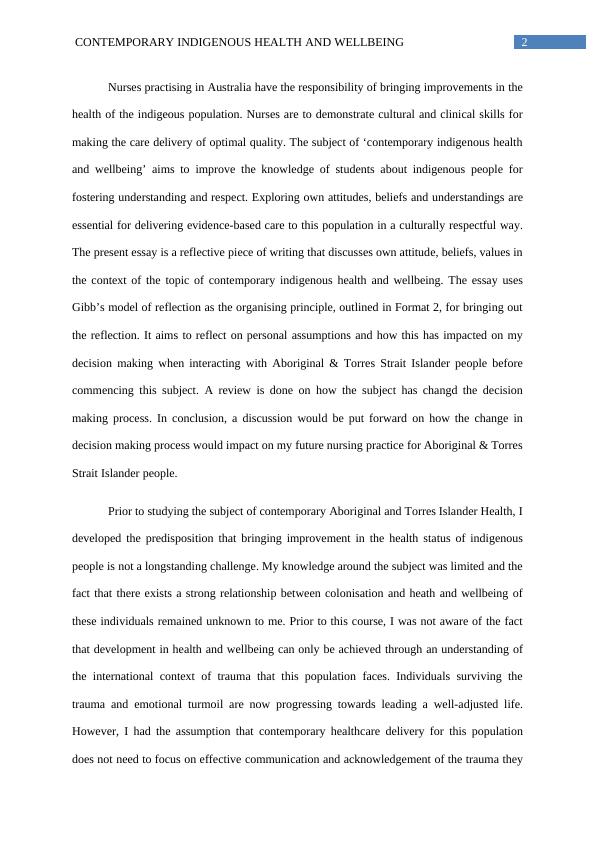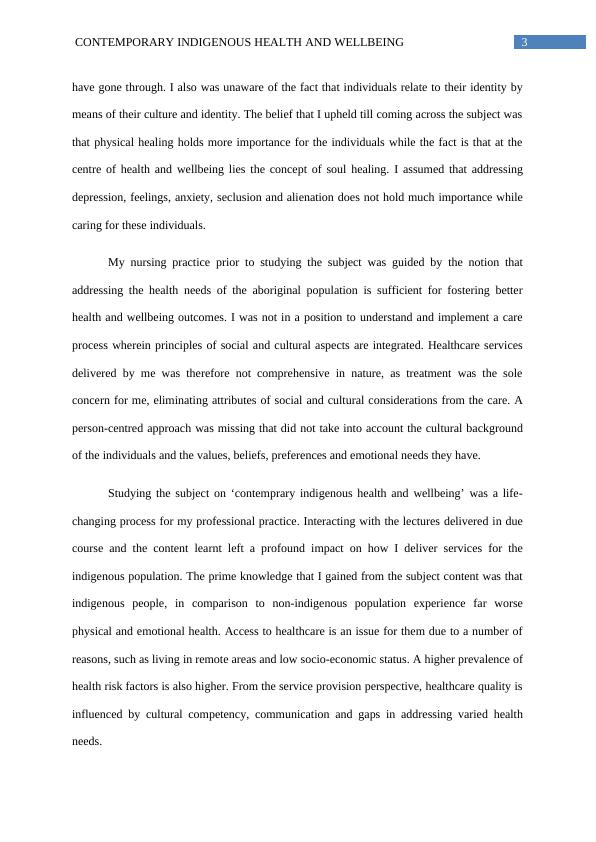Contemporary Indigenous Health and Wellbeing
7 Pages1916 Words49 Views
Added on 2020-03-16
Contemporary Indigenous Health and Wellbeing
Added on 2020-03-16
ShareRelated Documents
1Running head: CONTEMPORARY INDIGENOUS HEALTH AND WELLBEINGContemporary Indigenous Health and WellbeingName of student:Name of university:Author note:

2 CONTEMPORARY INDIGENOUS HEALTH AND WELLBEINGNurses practising in Australia have the responsibility of bringing improvements in thehealth of the indigeous population. Nurses are to demonstrate cultural and clinical skills formaking the care delivery of optimal quality. The subject of ‘contemporary indigenous healthand wellbeing’ aims to improve the knowledge of students about indigenous people forfostering understanding and respect. Exploring own attitudes, beliefs and understandings areessential for delivering evidence-based care to this population in a culturally respectful way.The present essay is a reflective piece of writing that discusses own attitude, beliefs, values inthe context of the topic of contemporary indigenous health and wellbeing. The essay usesGibb’s model of reflection as the organising principle, outlined in Format 2, for bringing outthe reflection. It aims to reflect on personal assumptions and how this has impacted on mydecision making when interacting with Aboriginal & Torres Strait Islander people beforecommencing this subject. A review is done on how the subject has changd the decisionmaking process. In conclusion, a discussion would be put forward on how the change indecision making process would impact on my future nursing practice for Aboriginal & TorresStrait Islander people. Prior to studying the subject of contemporary Aboriginal and Torres Islander Health, Ideveloped the predisposition that bringing improvement in the health status of indigenouspeople is not a longstanding challenge. My knowledge around the subject was limited and thefact that there exists a strong relationship between colonisation and heath and wellbeing ofthese individuals remained unknown to me. Prior to this course, I was not aware of the factthat development in health and wellbeing can only be achieved through an understanding ofthe international context of trauma that this population faces. Individuals surviving thetrauma and emotional turmoil are now progressing towards leading a well-adjusted life.However, I had the assumption that contemporary healthcare delivery for this populationdoes not need to focus on effective communication and acknowledgement of the trauma they

3 CONTEMPORARY INDIGENOUS HEALTH AND WELLBEINGhave gone through. I also was unaware of the fact that individuals relate to their identity bymeans of their culture and identity. The belief that I upheld till coming across the subject wasthat physical healing holds more importance for the individuals while the fact is that at thecentre of health and wellbeing lies the concept of soul healing. I assumed that addressingdepression, feelings, anxiety, seclusion and alienation does not hold much importance whilecaring for these individuals. My nursing practice prior to studying the subject was guided by the notion thataddressing the health needs of the aboriginal population is sufficient for fostering betterhealth and wellbeing outcomes. I was not in a position to understand and implement a careprocess wherein principles of social and cultural aspects are integrated. Healthcare servicesdelivered by me was therefore not comprehensive in nature, as treatment was the soleconcern for me, eliminating attributes of social and cultural considerations from the care. Aperson-centred approach was missing that did not take into account the cultural backgroundof the individuals and the values, beliefs, preferences and emotional needs they have. Studying the subject on ‘contemprary indigenous health and wellbeing’ was a life-changing process for my professional practice. Interacting with the lectures delivered in duecourse and the content learnt left a profound impact on how I deliver services for theindigenous population. The prime knowledge that I gained from the subject content was thatindigenous people, in comparison to non-indigenous population experience far worsephysical and emotional health. Access to healthcare is an issue for them due to a number ofreasons, such as living in remote areas and low socio-economic status. A higher prevalence ofhealth risk factors is also higher. From the service provision perspective, healthcare quality isinfluenced by cultural competency, communication and gaps in addressing varied healthneeds.

End of preview
Want to access all the pages? Upload your documents or become a member.
Related Documents
Contemporary Indigenous Health and Wellbeinglg...
|8
|2052
|465
Contemporary Indigenous Health and Wellbeinglg...
|8
|1920
|496
Factors Impacting Aboriginalslg...
|6
|904
|234
Assignment on Nursing Professionlg...
|5
|1286
|80
Contemporary and Indigenous Health and Wellbeing.lg...
|7
|1889
|2
Cultural Safety in Healthcarelg...
|8
|2356
|201
